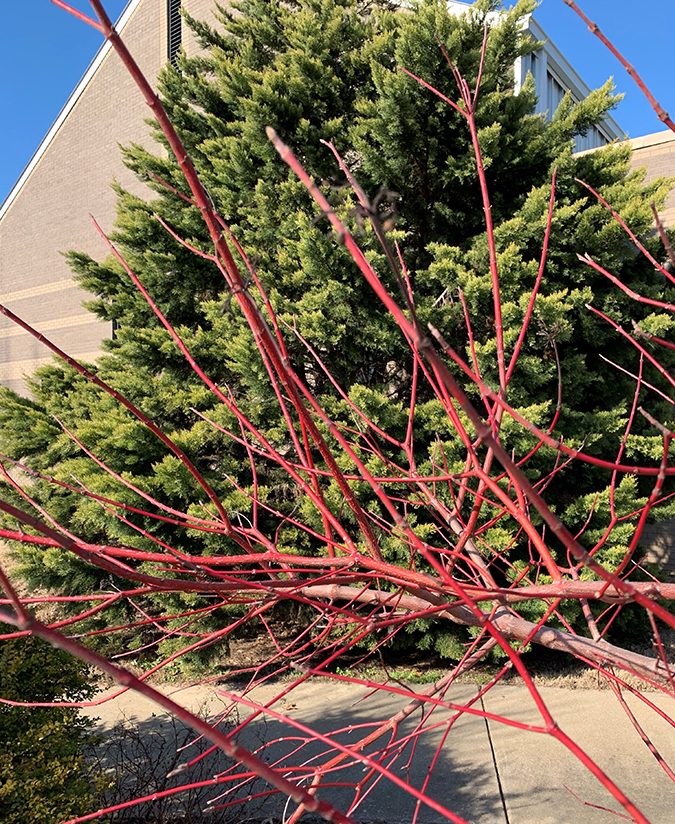| |
UT Gardens January 2020 Plant of the Month: 'Cayenne' Silky Dogwood
Submitted by Jason Reeves, research horticulturist, University of Tennessee Gardens, Jackson

The red twigs of silky dogwood Cornus amomum 'Cayenne' provide bright winter interest to the landscape at the UT Gardens, Jackson. Photo by J. Reeves, courtesy UTIA. |
I was first introduced to “red-twig" dogwoods by an elderly gardening friend about 25 years ago. She pointed out a large, multi-stemmed shrub growing out in the middle of her lawn called a red-twig dogwood. I had never heard of such and thought to myself “what a strange looking dogwood.” It was mid-summer and it did not look all that appealing to me, but I was so plant hungry at that time that I took any plant offered to me. She dug two suckers from the plant, and my mother and I planted them on the fence row at the farm. Wow, was I surprised come winter! The stems turned a beautiful red. I fell in love and wanted more. I asked about them at the local nurseries with no success. Finally, I found a yellow-stemmed one called ‘Flaviramea’. It struggled, and eventually died. I quickly found another one and planted it. It soon died, and, after doing some research, I discovered that 'Flaviramea' is highly susceptible to stem canker.
Red-twig dogwoods are hard to beat for their dramatic colorful show of stems in the winter. They are especially showy when grown with a background of conifers, or with snow on the ground. They are typically one of three species of Cornus: alba, sanquinea, or sericea. Some of the more common cultivars include: ‘Baileyi’, ‘Cardinal’, ‘Isanti’, Arctic Fire®, Arctic Sun® and ‘Winter Flame’ also known as ‘Midwinter Fire’. Unfortunately, they can all be short lived in the South as they are susceptible to canker/twig blight. However, that has never kept me from planting them. I typically get five or so years of enjoyment out of a plant in the garden before it succumbs. Potato chips don’t last long either but, I buy them over and over.
In the winter of 2011 while driving to Charlottesville, Virginia, Michael Dirr spotted a bright red-twig Cornus amomum growing in a swamp on the side of the highway. He waded out amongst the beavers to snag some cuttings and ‘Cayenne’ was born. Cornus amomum or silky dogwood, as it is commonly called, was not particularly known for its stem color until the roadside discovery of Cayenne. Silky dogwood is native along streams, edges of swamps, and other low areas across much of the eastern United States. It is not affected by stem canker like many other Cornus species.
Cayenne has fresh green foliage all summer. This shrub dogwod does not produce big showy flowers. Instead, numerous small white flowers looking similar to Queen Anne’s Lace are produced in flat cymes up to two inches wide on the end of the stems in May and June that give way to clusters of pea-size porcelain blue fruit in August and September. The fruits are enjoyed by birds. As the temperature drops the real show begins; leaves turn a striking orange-red before dropping to reveal bright red stems.
As with the other species of red-twig dogwoods, Cayenne is a multi-stemmed shrub that spreads by suckers. The best winter stem color occurs on young new growth. Once the stems are a couple of years old, the bark matures to gray. To ensure fresh colorful stems each year, older stems should be cut back close to the ground in late winter or early spring. Strong new stems will quickly spring forth. I like to cut some of the older stems in early December and use them in Christmas decorations both indoors and out. The stems work great placed in pots and beds for added winter interest. Outside, the cut stems will retain their color all winter long. In early March, I remove the rest of the older stems from the plant.
Hardy in zones 4-9, Cornus amonum ‘Cayenne’ thrives in full-sun to partial-shade and is best grown in good garden soil where supplemental water can be provided in periods of drought. It works well in shrub borders and mass plantings; in moist areas, it can form a dense colony making it great for wetland mitigation. In the garden, if left unpruned, it can reach 6-8 feet tall and 8-10 feet wide in three to five years, depending on moisture.
Thanks to Dr. Dirr, there is finally a red-twig dogwood that can be enjoyed even in southern gardens for many years, and I have more money to spend on potato chips!
The UT Gardens includes plant collections located in Knoxville, Crossville and Jackson. Designated as the official botanical garden for the State of Tennessee, the collections are part of the UT Institute of Agriculture. The Gardens’ mission is to foster appreciation, education and stewardship of plants through garden displays, educational programs and research trials. The Gardens are open during all seasons and free to the public. For more information, see the Gardens website: ag.tennessee.edu/utg.
Published January 9, 2020 |

